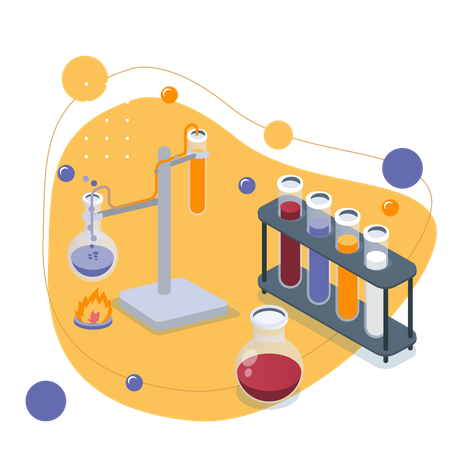Reactions of Acids with Metals (GCSE Chemistry)
Reactions of Acids with Metals
Reactions of Acids
Acids with Water and Metals
- Acids can dissolve in water. An acid is a substance which dissolves in water to produce hydrogen ions (H+). Acids can also react with some metals.
- Acids can form a salt and hydrogen gas. During a metal and acid reaction, acids form a salt and hydrogen gas. The hydrogen gas can be observed in the form of bubbles. These bubbles can be used to measure the rate of reaction.
- We can write out equations. Since acids and metals react to form a salt and hydrogen, we can express this as an equation:
Acid + Metal → Salt + Hydrogen
E.g. H2SO4 + Mg → MgSO4 + H2
What is a Redox Reaction?
- A redox reaction example is when metals react with acids. When a metal reacts with an acid, the loss and gain of electrons occurs simultaneously. This is known as a redox reaction, where spectator ions are present.
- Spectator ions remain the same. During a redox reaction, the spectator ions don’t lose or gain any electrons. They simply stay as an ion during the whole reaction.
- Metals are oxidised. During a neutralisation reaction, metals are oxidised. This means that the metal will lose electrons, becoming oxidised into a positive ion.
- Hydrogen is reduced. During a neutralisation reaction, hydrogen is reduced. This means that the hydrogen will gain electrons, becoming reduced into a hydrogen molecule.
Example Reactions between Metals and Acids
For exams, you need to be familiar with certain reactions involving metals and acids. We will outline some key examples in this section.
H2SO4 + Mg → MgSO4 + H2
2HCl + Zn → ZnCl2 + H2
Fe + 2HCl → FeCl2 + H2
Practice Question 1: Identify which species are reduced and oxidised in the reaction between sulfuric acid and magnesium.
1.Write the symbol equation. Firstly, we need to write out the metal and acid reaction equation and balance it.
H2SO4 + Mg → MgSO4 + H2
2. Separate out the ions in the equation. Remember that not all compounds have ionic bonds: some might be covalent. Also watch out for compounds which have 2 of the same ions.
2H+ SO42- + Mg → Mg2+ SO42- + H2
3. Identify the spectator ions. Now, look at the ions and cross out any which are the same on both sides of the equation.
2H+ SO42- + Mg → Mg2+ SO42- + H2
2H+ + Mg → Mg2+ + H2
4. Write the half equations. We need to write each set of half equations separately. In the half equation, we write the number of electrons gained or lost.
In this case, the 2 hydrogen ions have gained 2 electrons from the magnesium – 1 for each hydrogen ion. The magnesium has lost 2 electrons from its outer shell.
2H+ + 2e– → H2Mg – 2e– → Mg2+
5. Identify the oxidised and reduced species. From these half equations, we can see that Hydrogen has gained electrons and been reduced. Magnesium has lost electrons and been oxidised.
Practice Question 2: Identify which species are reduced and oxidised in the reaction between hydrochloric acid and zinc.
1.Write the symbol equation. Firstly, we need to write out the equation for the reaction and balance it.
2HCl + Zn → ZnCl2 + H2
2. Separate out the ions in the equation. Remember that not all compounds have ionic bonds: some might be covalent. Also watch out for compounds which have 2 of the same ions.
2H+ + 2Cl– + Zn → Zn+2 2Cl– + H2
3. Identify the spectator ions. Now, look at the ions and cross out any which are the same on both sides of the equation.
2H+ + 2Cl– + Zn → Zn+2 2Cl– + H2
2H+ + Zn → Zn+2 + H2
4. Write the half equations. We need to write each set of half equations separately. In the half equation, we write the number of electrons gained or lost.
In this case, the 2 hydrogen ions have gained 2 electrons from the Zinc – 1 for each hydrogen ion. The Zinc has lost 2 electrons from its outer shell.
2H+ + 2e– → H2
Zn -2e– → Zn+2
5. Identify the oxidised and reduced species. From these half equations, we can see that Hydrogen has gained electrons and been reduced. Zinc has lost electrons and been oxidised.
When an acid reacts with a metal, a chemical reaction occurs that results in the production of hydrogen gas (H2) and a salt.
Acids react with metals because they donate hydrogen ions (H+) to the metal, which results in the formation of hydrogen gas and a salt.
Most metals react with acids, but the reaction rate and the products produced vary depending on the metal and the acid used.
The products of the reaction between an acid and a metal are hydrogen gas (H2) and a salt.
The reaction between an acid and a metal is exothermic because energy is released in the form of heat during the reaction.
No, the reaction between an acid and a metal cannot be reversed.
The factors that affect the rate of the reaction between an acid and a metal include the concentration of the acid, the surface area of the metal, and the temperature.
The rate of the reaction between an acid and a metal can be increased by increasing the concentration of the acid, increasing the surface area of the metal, or increasing the temperature.
No, not all acids are equally reactive with metals. The reactivity of an acid with a metal depends on the strength of the acid and the nature of the metal.






Still got a question? Leave a comment
Leave a comment